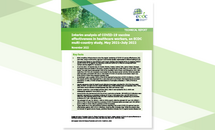Interim analysis of COVID-19 vaccine effectiveness in healthcare workers, an ECDC multi-country study, May 2021–July 2022
This document reports on one of ECDC’s multi-country studies in the hospital setting to measure product-specific COVID-19 VE against any laboratory-confirmed SARS-CoV-2 infection among healthcare workers (HCWs) eligible for vaccination.
Executive Summary
ECDC is building infrastructure to allow the regular monitoring of COVID-19 vaccine effectiveness (VE) over time, using a multi-country approach that involves studies implemented in different settings [1,2].
As of July 2022, 16 hospital sites (in Croatia, Estonia, Greece, Ireland, Italy, Latvia, Poland, Portugal, and Spain) have participated in the study, covering the period from 3 May 2021 to 19 July 2022. In this period, the study teams approached 2 832 HCWs, enrolled 2 629 of them, and followed up with 2 369 . Aside from 18 HCWs who remained unvaccinated during the study period, all other HCWs recruited to date have been vaccinated with one or more doses of COVID-19 vaccines at enrolment. Nearly two thirds (64%) of them have received a booster dose.
At enrolment, over a quarter (26%) of the HCWs reported having had a COVID-19 infection, of which the majority (87%) were diagnosed 46 or more days prior to enrolment. Serological results have been reported by 11 sites, of which all reported detection of anti-spike antibodies in >90% of HCWs at enrolment.
Genetic sequencing data for breakthrough infections have been submitted for 176 HCWs from eight sites, of which 116 were Omicron variant infections (B.1.1529) isolated since 15 December 2021. Thirty were Delta variant infections isolated between May 2021 and January 2022.
Omicron variant BA.1 was isolated until May 2022, when it was replaced by BA.2, which was subsequently replaced in June 2022 by BA.4/5.
Among HCWs who had received only the primary vaccination schedule, 196 SARS-CoV-2 infections were reported, representing a cumulative incidence of 2.9 per 1 000 person days, and 257 SARS-CoV-2 infections were reported among those who had a received a booster dose, representing a cumulative incidence of 2.7 per 1 000 person days.
The adjusted rVE was 7% (95%CI: -28% to 32%) overall, while the adjusted rVE was 11% (95%CI: -48% to 47%) in the HCWs reporting a previous COVID-19 episode before enrolment and -6% (95%CI -81% to 38%) in HCWs without a previous COVID-19 episode.
These results are in line with published evidence indicating that current COVID-19 vaccines have low effectiveness against mild Omicron infections, including after a booster dose. While this analysis does not include VE against severe disease, published literature indicates that VE against severe disease due to the Omicron variant is high following the administration of both the primary course and further maintained by a booster dose. Although point estimates of VE indicated some protective effects, the wide confidence intervals make the interpretation of the results difficult. The precision of the rVE estimates may improve through the continuation of the study in the participating sites (longer follow-up) or through the recruitment of new sites to increase the size of the HCW cohort.








